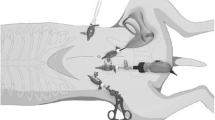Abstract.
Background: An experimental study was planned to evaluate the effect of bile alone and bile in combination with gallstones on intraperitoneal adhesion and abscess formation in the peritoneal cavity of the rat.
Methods: One hundred Sprague-Dawley rats were assigned to ten groups (n: 10). Groups 1–3 received a 1-ml intraperitoneal injection of saline, sterile bile, and infected bile. Groups 4–10 underwent a lower 5-mm midline abdominal incision. In groups 5, 7, and 9, a single gallstone (3-mm diameter) was placed in the right upper quadrant and injected with sterile saline, sterile bile, and infected bile, respectively. In groups 6, 8, and 10, four gallstones (3-mm diameter) were placed in the right upper quadrant together with sterile saline, sterile bile, and infected bile, respectively. Group 4 only underwent a 5-mm midline incision. All animals were sacrificed at the end of 4 weeks and the peritoneal cavity was carefully examined to investigate adhesions and abscess formation. The adhesions were graded according to Nair's gross pathologic grading of adhesions. The Kruskal-Wallis nonparametric test (KW) was used for statistical analysis.
Results: No intraabdominal lesions were noted in groups 1–3. The adhesion score was increased by number of stone and infected bile (G4: 3, G5: 3, G6: 11, G7: 7, G8: 10, G9: 15, G10: 18). But there was only a significant difference between the groups that received sterile saline + single stone (G5) and that receiving infected bile + four stones (G10) (KW: 24.3 P < 0.05). There was abscess formation in three rats in group 9 and two in group 10.
Conclusions: In conclusion, infected bile in combination with multiple stones increases the gross grading of adhesion and intraabdominal abscess formation. Thus, in cases with multiple stones and infected bile, the dropped stones should be retrieved and the peritoneal cavity should be copiously irrigated during laparoscopic cholecystectomy.
Similar content being viewed by others
Author information
Authors and Affiliations
Additional information
Received: 19 January 1996/Accepted: 23 February 1996
Rights and permissions
About this article
Cite this article
Zorluoğlu, A., Özgüç, H., Yilmazlar, T. et al. Is it necessary to retrieve dropped gallstones during laparoscopic cholecystectomy? . Surg Endosc 11, 64–66 (1997). https://doi.org/10.1007/s004649900296
Published:
Issue Date:
DOI: https://doi.org/10.1007/s004649900296



